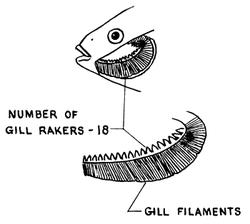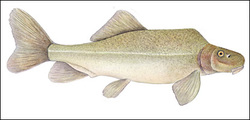|
This week's edition of Leena's Life Sciences Limelight, a column dedicated to research presentations in the life sciences on our campus, focuses on a September 24, 2013 presentation delivered by Dr. Gerald R. Smith, Curator Emeritus of the Museum of Zoology and Professor Emeritus of Ecology and Evolutionary Biology, during an EEB Department Seminar.  Jackson Lake, WY, taken from www.jacksonholenet.com Jackson Lake, WY, taken from www.jacksonholenet.com In his presentation, “Effects of Isolation on Introgression and Evolution in Western U.S. Freshwater Fishes” (September 24, 2013), Dr. Gerald R. Smith proposed a possible explanation for an unexpected result in field studies of modern evolutionary biology, which suggests that all of the diversity that arises actually constitutes a decrease in the preexisting diversity. Having presented three pictures including one of a fish species found on the rivers around the Yellowstone National Park area and two of mouths of the remnants of a species in Jackson Lake, which had introgressed with the fish in the surrounding rivers, Dr. Smith showed how the process of introgression has resulted in a significant loss of diversity. Citing the example of rainbow trout and cutthroat trout, which have hybridized with each other and, though not in all cases, undergone introgression (also known as introgressive hybridization), Dr. Smith explained how this precise type of phenomenon characterizes the examples of five forms of sucker, catostomus, chasmistes, xyrauchen, deltistes, and pantosteus, which constitute a tribe in the western United States, and which he has studied. Dr. Smith described how, particularly in dry periods historically, the landscape in the western U.S. involved hundreds of isolated basins amenable to fish isolation. The consequences of this isolation mean that during wet periods, many stream captures and lake overflows occur, which in turn spill whole populations of fish on top of preexisting populations, resulting in hybridization. Among the five forms of sucker, Dr. Smith presented morphology trees demonstrating generic groups with long divergent branches, and suggesting long evolution of the five suckers. Dr. Smith also presented DNA trees, which, by contrast, showed short branches connecting chasmistes, and that thus suggested recent (as opposed to early) evolutionary divergence. Dr. Smith’s research problem has emerged in light of these precise disparities in branch lengths from morphology and DNA trees, and the conflicting DNA evidence, both mitochondrial and nuclear DNA evidence, represents the major source of controversy. Dr. Smith discussed how the two hypotheses proposed for the short branch lengths and the arrangements of these particular taxa in the DNA trees (i.e. no clades) explain this phenomenon as a result of either introgression or a result of ecophenotypic variation. Dr. Smith expressed his preferred hypothesis of introgressive hybridization, with replacement of DNA, to explain this abovementioned difference.  Taken from fao.org Taken from fao.org Dr. Smith noted that notwithstanding his preference, introgression remains regarded as “untestable” by other ichthyological researchers. Despite these odds, Dr. Smith and colleagues tested the introgression hypothesis and employing a practice pioneered by Edgar Anderson in 1946, sought to distinguish hybridization from introgression. Specifically, Dr. Smith discussed how fossils provided a test of antiquity of morphological lineages vs. short times implied by short ranches on the DNA trees. Dr. Smith and colleagues analyzed many fossils of suckers, which could provide diagnostic evidence of lineage antiquity. Generating graphs based on various morphological features including lower lip lengths, gill raker number, and jaw cartilage widths, among other features, Dr. Smith elucidated varying patterns of fitness and variation that indicated the effects of introgression on evolution and distinguished these effects from hybridization.  Razorback Sucker, taken from ksj.mit.edu Razorback Sucker, taken from ksj.mit.edu Hybridization, Dr. Smith explained, occurs where we have a parent from each of two different clades that reproduce, have F1 offspring, and that, at this stage, the F1 offspring remain all in the same cluster, because the chromosomes are not segregated at this stage, and the next stage that occurs, or does not occur, represents introgression; at this stage, the F1s reproduce with one or both of their parents, breaks up and produces intermediate offspring that are extremely variable, or at least more variable than F1. To illustrate, Dr. Smith explained how the Tahoe and Lahontan Sucker in western Nevada differ by various jaw characters. Dr. Smith showed two fairly looking normal parental clusters, and colors indicating lip measurements, with a very tight cluster of intermediates, which he interpreted as the F1s (no back-crossing), and thus introgression had not occurred. Dr. Smith explained how on the other hand, the Sonora Sucker shares its genes with the Razorback Sucker, which is a totally different fish, and the results of this are a parent with a slightly enlarged cluster for the intermediates, in a position that suggests backcrossing with the Sonora Sucker. Isolated replicates suggested loss of specialized traits and introgressive loss of parents in the mix.  Utah Lake, taken from utahlake.gov Utah Lake, taken from utahlake.gov Concentrating on lake suckers that live in the Upper Klamath, Utah and Jackson lakes, Dr. Smith showed how the Utah Lake, which is unique in the West as it still has a favorable ecological situation with plenty of plankton despite that fact that water has been diverted, is the only lake that retained its specialized morphology for feeding plankton. The feeding niches and specialized structures are not lost in this lake either, and the amount of hybridization is still pretty minimal. Quite the opposite situation occurred in the Upper Klamath Lake, Dr. Smith showed, as the lake suckers that live inside this lake have different feeding niches, yet all four species meet each other in the surrounding spawning tributaries. Dr. Smith discussed how hardly a month goes by and we do not see pictures in the newspapers, of farmers armed with guns and pitchforks, managing the irrigation headwater ditch gates, in order to get water for their hay. One hundred years ago, all of the abovementioned lakes had very specialized plankton-feeding fish, with very little indication of hybridization. When, in the west as happens in tributaries to every body of water, dams are built and water is take out to irrigate fields, then the rivers are reduced ten-flow so that they have little volume and fewer ripples on which the species migrate to spawn. When species migrate to spawn now, they are met by another population. Thus because of water wars like these, the Upper Klamath lake has an interesting situation in which the two Catostomus, the lost sucker, and the Chasmistes, the shortnose lake sucker, have all intergressed; consequently, fish that were originally easy to tell apart are now significantly mixed up. As a result, half of the population now cannot be assigned to any of these taxa.  Catostomus, taken from zeus.collegeofidaho.edu Catostomus, taken from zeus.collegeofidaho.edu In discussing the detection of a possible role of selection in this situation, Dr. Smith explained how when the introgressing populations are isolated from immigration, then mixing of traits over time can be attributed to neutral fertility and survival, as in the Pantosteus case where the parents basically disappeared, except that some traits persist longer than others in some cases where they can be followed for a number of years. But in the lakes, Dr. Smith explained how the specialized structures are gradually mixed and lost to the incoming catostomus “river” genes, suggesting immigration as opposed to different fitness or differential survival. He mentioned that a footnote to this is that successful fertility and survival of these backcross products suggests that there are few constraining “adaptive gene complexes” (i.e. a gene groups of individuals or of potentially interbreeding groups, which constitute an interacting functional unit). Dr. Smith stated that 16 cases of introgression are documented among 24 catostomin species, with 11 of these cases existing between old genera. Dr. Smith summarized by stating that introgression is common in western American castostomids (and cyprinids and salmonids), molecular and morphological phylogenies reflect different evolutionary histories, consequences of introgression range from changes in characters to amalgamation of species and loss of specialized traits, and that the immigration of genes from outside the specialized trophic system may be more important than differential fitness of traits in determining the outcome of these situations. About the Blogger Leena Shah is a sophomore in the College of Literature, Science and the Arts at the University of Michigan concentrating in International Studies with a focus on Global Environment and Health. Her literary interests include religion, slavery, and the politics of knowledge production.
0 Comments
Leave a Reply. |
WELCOME, UMICH SCIENTISTAS!
CAMPUS PICS
WHAT'S NEWUPCOMING EVENTSPAST POSTS
October 2022
SORT BY TAG |
The Scientista Foundation, Inc. All Rights Reserved © 2011-2021 | Based in NY | [email protected]
The Network for Pre-Professional Women in Science and Engineering
The Scientista Foundation is a registered 501(c)(3) -- Donate!
The Network for Pre-Professional Women in Science and Engineering
The Scientista Foundation is a registered 501(c)(3) -- Donate!


 RSS Feed
RSS Feed